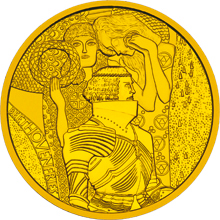| Beethoven Frieze | |
|---|---|
 | |
| Artist | Gustav Klimt |
| Year | 1901–1902 [1] |
| Medium | Charcoal, graphite, black, red and coloured chalk, pastel, casein colours, gold, silver, gilt stucco, applications (mother-of-pearl buttons, brass uniform buttons, mirror fragments, ground glass, brass curtain rings, upholstering nails, semi-precious stones) on mortar render over reed matting [1] |
| Location | Secession Building, Vienna, Austria |
The Beethoven Frieze (German: Beethovenfries) is a painting by Gustav Klimt on display in the Secession Building, Vienna, Austria. [2]





